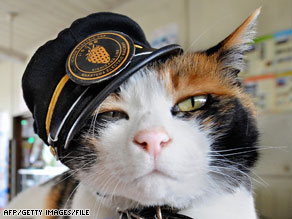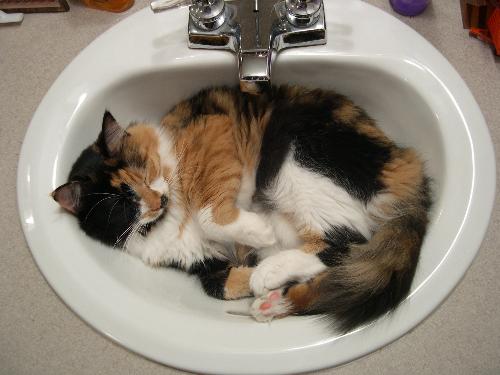There are many cat loving people who are under the impression that cats are un-trainable creatures. The belief is that a cat is too moody and snobbish to adhere to the commands of its owners. However, often times, cats do not comply with their owner’s request simply because they do not understand what is being asked of them.
While training a dog is somewhat difficult and time consuming, training a cat takes a much more calm, relaxed, patient and devoted individual. When training a dog, negative reinforcement is usually adhered to for disobedience; however, a cat will not respond to training that is reinforced with anything other than positive reinforcement.
Large amounts of praise when your cat has complied with the task that has been requested will ensure your feline grasps a better understanding of what is expected. Typically, you should start training your cat when it is about eight to ten weeks of age, although an older cat is still quite capable and willing to learn a few new tricks.
When you start training your cat, it is important to decide on a quiet place to practice. Noise and confusion will only distract him from what is trying to be accomplished. Another essential tool to have when training your cat, is an endless supply of his favorite cat treats to be used in implementing positive reinforcement.
As with training a puppy or dog, it is important to work on only one command at a time. Introducing several different commands at once will only lead to frustration and anger. The best command to start training your cat with is by fat the easiest and that is, to come when he is called. All commands, no matter what the situation, should be kept short and to the point. For teaching your cat to come when he is called, a simple “Here Kitty” or “Come Kitty” works best.
In order to effectively teach your cat his first command, you must first get down on his level. Sitting or kneeling on the floor, call out the command that you have chosen to call him to you. If your cat responds, give him plenty of praise and show an immense amount of excitement, followed by his favorite treat.
After the first try, wait for your kitten to travel away from you. Then, move to another area of the room and call him again. If your cat responds, repeat the same praise and treat routine you enlisted previously. It is important to note, not to work on training your cat for more than ten minutes at a time. If you notice that your cat is acting bored or frustrated, it is now time to stop.
Trying to train your cat when he is not truly interested will only upset you and your cat. In order for the trick or command to be learned, training should be done two to three times a day for one week. If after that time, your cat has successfully learned the command; it is now permittable to start teaching him a new command.
Cat Crate and Leash Training
Crate training and harness and leash training are very important things that must be taught to your cat for his own safety and well being. Traveling for long distances or a trip to the veterinarian can become quite frustrating if your cat is upset by being attached to a leash or confined in a small crate.
In order to teach your kitten to use a leash and a harness, it is important to introduce them both gradually. First, start by placing the harness on him, making sure it is not too tight.
Allow him to walk around the house with it on for about twenty minutes or so. Repeat this one or two times a day for about a weak. Once your cat is used to wearing the harness, it is now time to introduce the leash. The best way to do this, is to attach the leash to the harness, but do not pull on it. Only allow your cat to drag it around while maneuvers through the home, but be careful to watch and be sure it does not get caught up on anything that could potentially become harmful or dangerous.
When your cat is used to dragging around the leash, gently pick it up, showing him it is okay for you to have it. Be sure to speak in a calm and soothing voice. Then, as you call your cat, give the leash a gentle tightening. You can use treats to coax your cat into following you around and this should help enlist the positive reinforcement.
Crate training is a bit easier. It is important that you have a cozy blanket and your kitten’s favorite toy inside. As you place your kitten inside the crate, praise him. After only about two to three minutes, let your kitten out, but when doing so, do not make an excited or lavish gesture about it. Performing this several times over while extending the length of time gradually will eventually have your kitten feeling quite comfortable in his private crate hideaway for about an hour or two.
While training a dog is somewhat difficult and time consuming, training a cat takes a much more calm, relaxed, patient and devoted individual. When training a dog, negative reinforcement is usually adhered to for disobedience; however, a cat will not respond to training that is reinforced with anything other than positive reinforcement.
Large amounts of praise when your cat has complied with the task that has been requested will ensure your feline grasps a better understanding of what is expected. Typically, you should start training your cat when it is about eight to ten weeks of age, although an older cat is still quite capable and willing to learn a few new tricks.
When you start training your cat, it is important to decide on a quiet place to practice. Noise and confusion will only distract him from what is trying to be accomplished. Another essential tool to have when training your cat, is an endless supply of his favorite cat treats to be used in implementing positive reinforcement.
As with training a puppy or dog, it is important to work on only one command at a time. Introducing several different commands at once will only lead to frustration and anger. The best command to start training your cat with is by fat the easiest and that is, to come when he is called. All commands, no matter what the situation, should be kept short and to the point. For teaching your cat to come when he is called, a simple “Here Kitty” or “Come Kitty” works best.
In order to effectively teach your cat his first command, you must first get down on his level. Sitting or kneeling on the floor, call out the command that you have chosen to call him to you. If your cat responds, give him plenty of praise and show an immense amount of excitement, followed by his favorite treat.
After the first try, wait for your kitten to travel away from you. Then, move to another area of the room and call him again. If your cat responds, repeat the same praise and treat routine you enlisted previously. It is important to note, not to work on training your cat for more than ten minutes at a time. If you notice that your cat is acting bored or frustrated, it is now time to stop.
Trying to train your cat when he is not truly interested will only upset you and your cat. In order for the trick or command to be learned, training should be done two to three times a day for one week. If after that time, your cat has successfully learned the command; it is now permittable to start teaching him a new command.
Cat Crate and Leash Training
Crate training and harness and leash training are very important things that must be taught to your cat for his own safety and well being. Traveling for long distances or a trip to the veterinarian can become quite frustrating if your cat is upset by being attached to a leash or confined in a small crate.
In order to teach your kitten to use a leash and a harness, it is important to introduce them both gradually. First, start by placing the harness on him, making sure it is not too tight.
Allow him to walk around the house with it on for about twenty minutes or so. Repeat this one or two times a day for about a weak. Once your cat is used to wearing the harness, it is now time to introduce the leash. The best way to do this, is to attach the leash to the harness, but do not pull on it. Only allow your cat to drag it around while maneuvers through the home, but be careful to watch and be sure it does not get caught up on anything that could potentially become harmful or dangerous.
When your cat is used to dragging around the leash, gently pick it up, showing him it is okay for you to have it. Be sure to speak in a calm and soothing voice. Then, as you call your cat, give the leash a gentle tightening. You can use treats to coax your cat into following you around and this should help enlist the positive reinforcement.
Crate training is a bit easier. It is important that you have a cozy blanket and your kitten’s favorite toy inside. As you place your kitten inside the crate, praise him. After only about two to three minutes, let your kitten out, but when doing so, do not make an excited or lavish gesture about it. Performing this several times over while extending the length of time gradually will eventually have your kitten feeling quite comfortable in his private crate hideaway for about an hour or two.


 RSS Feed
RSS Feed